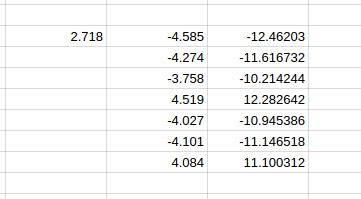GeForce GTX 1070 (8GB)
ASRock Z170M Pro4S [Intel Z170chipset]
Ubuntu 14.04 LTS desktop amd64
TensorFlow v0.11
cuDNN v5.1 for Linux
CUDA v8.0
Python 2.7.6
IPython 5.1.0 -- An enhanced Interactive Python.
sine curveを学習した時のweightとbiasをもとに自分でネットワークを再現して出力を計算しようとしている。
convolutionを実装することになりそう。
Pythonのndarrayはほとんどわからないが、とりあえず実装を試みている。
資料 https://docs.scipy.org/doc/numpy/reference/arrays.ndarray.html
資料 http://anh.cs.luc.edu/python/hands-on/3.1/handsonHtml/ifstatements.html
参考 http://qiita.com/7of9/items/586f62fa46dc3409d954 のコメント
参考 http://qiita.com/7of9/items/06fee8f425c7a514377b#comment-70abc9bc48ed226fd6c5
code v0.1
import numpy as np
model_var = np.load('model_variables.npy')
print "all shape:",(model_var.shape)
def calc_conv(src, weight, bias):
wgt = weight.shape
print wgt # debug
conv = list(range(bias.size))
if wgt[0] == 1:
for idx2 in range(wgt[1]):
conv[idx2] = src * weight[0,idx2]
else:
for idx1 in range(wgt[0]):
for idx2 in range(wgt[1]):
conv[idx2] = src[idx1] * weight[idx1,idx2]
return conv # return list
indata = 2.718 # for (1,N) e.g. (1,7)
inp1_weight = model_var[2]
inp1_bias = model_var[3]
# indata = [1,2,3,4,5,6,7] # for (N,N) e.g. (7,7)
# inp1_weight = model_var[4]
# inp1_bias = model_var[5]
conv1 = calc_conv(indata, inp1_weight, inp1_bias)
print (inp1_weight)
print (inp1_bias)
print ('conv:',conv1)
結果は以下。
$ python read_model_var.py all shape: (10,) (1, 7) [[-4.58573723 -4.27450418 -3.75889063 4.51949883 -4.02780342 -4.10122681 4.0842309 ]] [ 0.97008353 0.70625514 0.27048966 -0.83405548 0.57475132 0.64893931 -0.45576799] ('conv:', [-12.464033786773681, -11.618102374076843, -10.216664729118348, 12.283997806549072, -10.947569698333741, -11.14713446044922, 11.10093958568573])
conv:に関して、google spreadsheetと近い値は出た。
課題
if wgt[0] == 1:として処理を分けている。
else:の処理だけでしようとすると以下のように怒られた。
Traceback (most recent call last):
File "read_model_var.py", line 30, in
conv1 = calc_conv(indata, inp1_weight, inp1_bias)
File "read_model_var.py", line 19, in calc_conv
conv[idx2] = src[idx1] * weight[idx1,idx2]
TypeError: 'float' object has no attribute 'getitem'
if wgt[0] == 1:なしで実装する方法は調査を要する。
code v0.2
そもそも
indata = 2.718 # for (1,N) e.g. (1,7)
は
indata = [ 2.718 ] # for (1,N) e.g. (1,7)
が正しかった。
1つのfloatではなく、1要素のリストを扱うのだった。
以下のコードになった。
# import sys
import numpy as np
model_var = np.load('model_variables.npy')
print "all shape:",(model_var.shape)
def calc_conv(src, weight, bias):
wgt = weight.shape
print wgt # debug
conv = list(range(bias.size))
for idx1 in range(wgt[0]):
for idx2 in range(wgt[1]):
conv[idx2] = src[idx1] * weight[idx1,idx2]
return conv # return list
indata = [ 2.718 ] # for (1,N) e.g. (1,7)
inp1_weight = model_var[2]
inp1_bias = model_var[3]
# indata = [1,2,3,4,5,6,7] # for (N,N) e.g. (7,7)
# inp1_weight = model_var[4]
# inp1_bias = model_var[5]
conv1 = calc_conv(indata, inp1_weight, inp1_bias)
print (inp1_weight)
print (inp1_bias)
print ('conv:',conv1)
code v0.3 (add bias)
'''
v0.3 Dec. 07, 2016
- calc_conv() > add bias
v0.2 Dec. 07, 2016
- fix calc_conv() treating src as a list
v0.1 Dec. 07, 2016
- add calc_conv()
'''
import numpy as np
model_var = np.load('model_variables.npy')
print "all shape:",(model_var.shape)
def calc_conv(src, weight, bias):
wgt = weight.shape
print wgt # debug
#conv = list(range(bias.size))
conv = [0.0] * bias.size
# weight
for idx1 in range(wgt[0]):
for idx2 in range(wgt[1]):
conv[idx2] = conv[idx2] + src[idx1] * weight[idx1,idx2]
# bias
for idx2 in range(wgt[1]):
conv[idx2] = conv[idx2] + bias[idx2]
return conv # return list
indata = [ 2.718 ] # for (1,N) e.g. (1,7)
inp1_weight = model_var[2]
inp1_bias = model_var[3]
# indata = [1,2,3,4,5,6,7] # for (N,N) e.g. (7,7)
# inp1_weight = model_var[4]
# inp1_bias = model_var[5]
conv1 = calc_conv(indata, inp1_weight, inp1_bias)
print (inp1_weight)
print (inp1_bias)
print ('conv:',conv1)
code v0.4 > 2x2 network example added
入力が複数の場合の例として、2x2のネットワーク計算用データを追加。
ndarrayの用意の仕方は以下を参考にしました。情報感謝です。
http://qiita.com/richi40/items/6b3af6f4b00d62dbe8e1
'''
v0.4 Dec. 10, 2016
- add 2x2 network example
v0.3 Dec. 07, 2016
- calc_conv() > add bias
v0.2 Dec. 07, 2016
- fix calc_conv() treating src as a list
v0.1 Dec. 07, 2016
- add calc_conv()
'''
import numpy as np
model_var = np.load('model_variables.npy')
print "all shape:",(model_var.shape)
def calc_conv(src, weight, bias):
wgt = weight.shape
print wgt # debug
#conv = list(range(bias.size))
conv = [0.0] * bias.size
# weight
for idx1 in range(wgt[0]):
for idx2 in range(wgt[1]):
conv[idx2] = conv[idx2] + src[idx1] * weight[idx1,idx2]
# bias
for idx2 in range(wgt[1]):
conv[idx2] = conv[idx2] + bias[idx2]
return conv # return list
# indata = [ 2.718 ] # for (1,N) e.g. (1,7)
# inp1_weight = model_var[2]
# inp1_bias = model_var[3]
# indata = [1,2,3,4,5,6,7] # for (N,N) e.g. (7,7)
# inp1_weight = model_var[4]
# inp1_bias = model_var[5]
indata = [ 3, 1 ] # for 2x2 network
inp1_weight = np.array([ [4,1], [5,9] ], dtype=np.float)
inp1_bias = np.array([ 2, 6 ], dtype=np.float)
conv1 = calc_conv(indata, inp1_weight, inp1_bias)
print (inp1_weight)
print (inp1_bias)
print ('conv:',conv1)
$ python read_model_var.py
all shape: (10,)
(2, 2)
[[ 4. 1.]
[ 5. 9.]]
[ 2. 6.]
('conv:', [19.0, 18.0])
試したネットワークは以下。1,3はinput。6,2はbias。線上の値はweight。

3x4 + 1x5 + 2 = 19
3x1 + 1x9 + 6 = 18
合っていそう。
問題はTensorFlowの実行結果のweightのオーダー(column major order / row major orderのどちらか)。
実際に計算をして大幅にずれないか確認することになりそうか。
